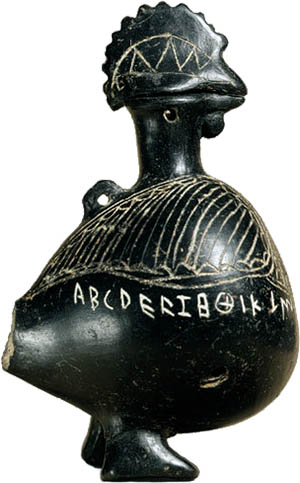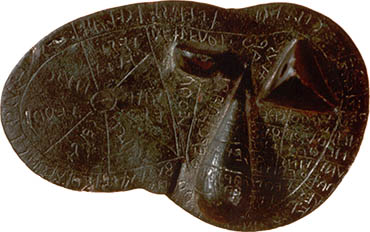
14
Bucchero Rooster
Etruscan
This small (about 4" tall) rooster-shaped terracotta vase was a container of some kind, with the head serving as the cork. Beyond that, however, its use is anyones guess. It has been described as a toy, an inkstand or a small jug. But that really doesn’t matter; important to us is the Etruscan abecderium inscribed in its belly. The vessel dates to about 700–650 BC, making it one of the earlier known Etruscan inscriptions.
Bucchero, considered the national pottery of Etruria, was as method perfected by the Etruscans where the glaze was burnished then fired with wood added to the kiln, resulting in a lustrous black finish.1 It was produced throughout Etruria and widely exported. The rooster was produced during the height of its popularity, in the so-called Orentializing period. The technique was largely replaced by painted pottery by the fifth century BC.
Because they left no written history, little is known about the Etruscans. It appears that they descended from the Villanovan culture and by ca.800 BC had developed confederacies of city-states in Central and Northern Italy and became the dominant culture on the Italic peninsula. By 500 BC they had expanded their empire northeast to the Adriatic and, along the Tyrrhenian, as far South as Campania. After a disastrous defeat at the Battle of Cumae (474 BC) and a later Gallic invasion in the North the Etruscan civilization began to decline. By the first century BC all Etruscan territories had been annexed by the Romans.
The Liver of Piacenza2
As early as 740 BC Greeks from Euboa established trading posts and colonies on the Italic peninsula at Cumae and Ischia.3 It was likely here that the Etruscans were introduced to the Euboean Greek alphabet (also known as the Cumae Greek alphabet). They quickly adopted it for their language. Initially they used most of the Greek letters, and wrote, like Greek at the time, right to left. Over the next few hundred years the Etruscan alphabet was further adapted to their language, and ca.400 BC a cleaned up 20-letter alphabet, written left to right, became the standard throughout Etruria.

Over the next few hundred years Etruscan became increasingly diluted by Latin and by the first century BC it had died out altogether, but, by this time, Etruscan had already served as the parent of most Italic alphabets, including Faliscan, Marsilianan, Messapic, Oscan, Picene (both North and South), Umbrian, Venetic, and most importantly, Latin.
1. For the technically minded: adding wood to the kiln caused oxygen to be partially replaced by carbon monoxide, a process known as reducing firing – a classic example of an oxidation-reduction reaction. The organic material is oxidized and the red iron oxides in the clay are reduced to black iron oxides (i.e. Fe2O3 → FeO, or simply FeII → FeIII).
2. The Liver of Piacenza, dated to 200–100 BC, was apparently an aid to divining the future from the still-warm livers of slaughtered sheep. According to historical information the practice of haruspicy (the foretelling of the future from animal entrails) was introduced to the Etruscans by the Hittites. This has nothing to do with the Bucchero Rooster but there are so few Etruscan inscriptions you take what you can get.
3. Over the next 150 years a Greek diaspora seeking new trade outposts, leaving because of famine and overcrowding, or escaping persecution at home, colonized much of Southern Italy and Sicily, an area known by the Romans as the Magna Graecia (Greater Greece) and by the Greeks as Megalê Hellas (Μεγάλη Ἑλλάς).
20 Jan 2009, updated 28 Dec 2011 ‧ Typographia Historia
